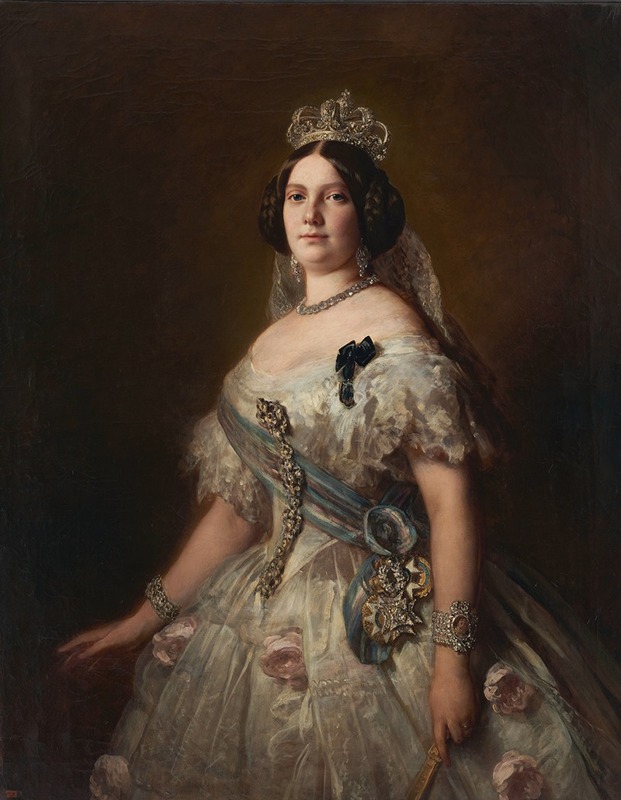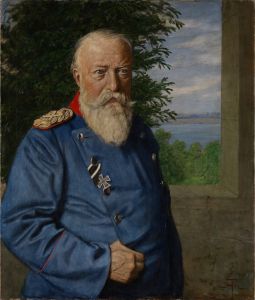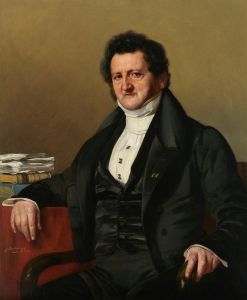
Isabella, Queen of Spain
A hand-painted replica of Franz Xaver Winterhalter’s masterpiece Isabella, Queen of Spain, meticulously crafted by professional artists to capture the true essence of the original. Each piece is created with museum-quality canvas and rare mineral pigments, carefully painted by experienced artists with delicate brushstrokes and rich, layered colors to perfectly recreate the texture of the original artwork. Unlike machine-printed reproductions, this hand-painted version brings the painting to life, infused with the artist’s emotions and skill in every stroke. Whether for personal collection or home decoration, it instantly elevates the artistic atmosphere of any space.
Franz Xaver Winterhalter's painting "Isabella, Queen of Spain" is a notable work by the German portrait artist, renowned for his depictions of royalty and high society in the 19th century. Winterhalter was born in 1805 in the Grand Duchy of Baden, and he became one of the most sought-after portraitists of his time, known for his ability to capture the elegance and grace of his subjects.
The painting features Isabella II of Spain, who reigned as Queen from 1833 to 1868. Isabella ascended to the throne at a young age following the death of her father, King Ferdinand VII. Her reign was marked by political instability, including numerous uprisings and the Carlist Wars, which were conflicts over the succession to the Spanish throne. Despite these challenges, Isabella II remained a significant figure in Spanish history.
Winterhalter's portrait of Queen Isabella II is celebrated for its exquisite detail and the artist's skillful use of color and light. The painting captures the queen in a regal pose, adorned in luxurious attire that reflects her royal status. Winterhalter's attention to detail is evident in the intricate rendering of the fabrics and jewelry, which were characteristic of his style. The portrait not only serves as a representation of Isabella II but also as a testament to Winterhalter's ability to convey the personality and stature of his subjects.
Winterhalter's work was highly regarded by European royalty, and he became a favorite among many royal courts. His portraits were known for their flattering portrayal of subjects, often idealizing their appearance while maintaining a sense of realism. This approach made his works popular among his patrons, who appreciated the combination of elegance and accuracy.
The painting of Isabella II is part of Winterhalter's broader body of work that includes portraits of other notable figures of the time, such as Empress Eugénie of France and Queen Victoria of the United Kingdom. His ability to capture the essence of his subjects made him a prominent figure in the art world during the 19th century.
Winterhalter's portraits are often characterized by their romantic style, which was influenced by the artistic movements of his time. His use of soft brushstrokes and a delicate color palette contributed to the ethereal quality of his paintings. This style is evident in the portrait of Isabella II, where the interplay of light and shadow adds depth and dimension to the composition.
The painting of Isabella, Queen of Spain, remains an important piece in the study of 19th-century portraiture. It exemplifies Winterhalter's mastery of the genre and his ability to capture the dignity and poise of his royal subjects. The work continues to be appreciated for its artistic merit and historical significance, offering insight into the life and reign of one of Spain's notable monarchs.
Overall, Franz Xaver Winterhalter's portrait of Isabella II is a distinguished example of his work, reflecting both the artist's technical skill and his capacity to convey the grandeur of his subjects. The painting stands as a significant contribution to the art of portraiture and remains a valuable piece for those interested in the history of European royalty and 19th-century art.


















